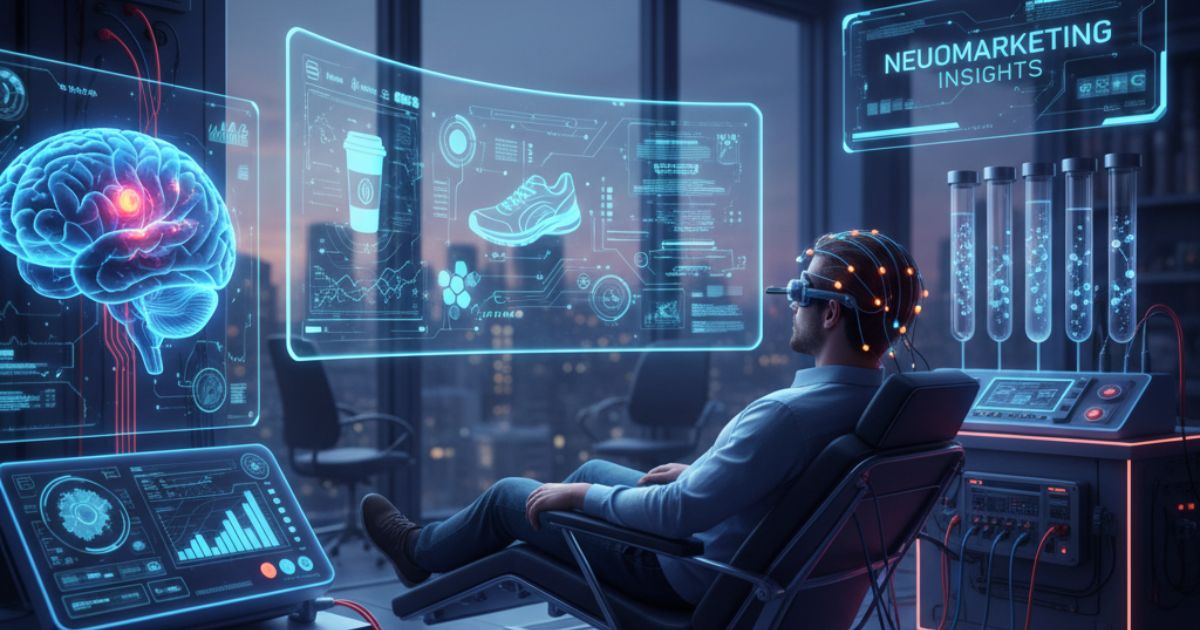Neuromarketing: How Brain Science Shapes Unforgettable Brand Experiences

Traditional marketing often struggles to grab attention in endless ads and distractions. People no longer respond to just prices or fancy slogans—they want real, emotional experiences that feel personal and meaningful. This is where Neuromarketing, or neuroscience-driven branding, makes a difference.
By understanding how the human brain reacts to visuals, emotions, and memories, brands can create stronger connections with their audience. Neuromarketing uses brain science and consumer psychology insights to design messages that speak to the subconscious mind. This helps brands build emotional trust, improve recall, and encourage customer loyalty.
This guide will break down the key principles of neuroscience in branding—including emotional triggers, sensory design, mirror neurons, and cognitive biases. You’ll also learn simple, practical ways to apply these insights to your marketing strategy and see how leading brands use brain-based techniques to drive growth and engagement.
What Is Neuromarketing? A Brief Overview
Neuromarketing bridges the gap between neuroscience and consumer research. It employs scientific tools—such as EEG (electroencephalography), fMRI (functional magnetic resonance imaging), eye tracking, and biometrics—to observe how different brain parts respond to marketing stimuli. By identifying neural correlates of attention, emotion, and memory encoding, neuromarketers gain actionable insights into what resonates most with their audience. Instead of relying on self-reported surveys or focus groups, which can be biased or inaccurate, brands can measure real-time physiological and neurological reactions to optimize messaging, design, and user experience.
Emotional Triggers: The Key to Memory Encoding

Emotions are powerful. When a marketing message elicits joy, surprise, or even mild sadness, the amygdala—a brain region central to emotion processing—becomes highly active. This activation strengthens synaptic connections in the hippocampus, the brain’s memory center, ensuring that emotional moments stick. For branding, tapping into these emotional triggers means crafting stories, visuals, and experiences that resonate on a human level. Whether it’s a heartfelt video, a nostalgic jingle, or a compelling narrative arc, triggering emotion increases the likelihood that consumers will remember your brand long after they leave the page or scroll past your ad.
Visual and Sensory Stimuli: More Than Meets the Eye
Humans process visuals 60,000 times faster than text. Color psychology, shape, and imagery are crucial in branding. Neuroscience reveals that certain hues can evoke specific feelings—blue fosters trust, red ignites excitement, and green communicates growth or sustainability. Beyond color, multisensory branding—incorporating sound, texture, scent, and even taste—can create a more immersive experience. Think of a boutique hotel with signature scents in its lobby or a retail store that pairs curated music playlists with soft-touch packaging. These sensory cues create a richer neural imprint, making the brand experience more memorable and emotionally engaging.
Mirror Neurons and Social Proof
Mirror neurons are brain cells that fire when we act and observe someone else performing it. They underpin empathy, imitation, and social learning. For brands, harnessing mirror-neuron activation means showcasing real people using, enjoying, or benefiting from a product or service. User-generated content, testimonials, and influencer collaborations tap into this neural mechanism. When prospects see someone like them smiling with your product, their mirror neurons light up, creating a subconscious sense of ‘I want that feeling too.’
Cognitive Biases: Framing, Anchoring, and Loss Aversion
The brain relies on shortcuts, known as cognitive biases, to make quick decisions. Savvy brands frame offers to exploit these biases ethically. Anchoring sets a reference point—listing a premium package first makes the mid-tier option appear more affordable. Loss aversion highlights what consumers stand to lose if they don’t act—”Only five seats left” is more compelling than “Seats available.” The framing effect presents information positively (“95% success rate”) rather than negatively (“5% failure rate”). By understanding and respecting these mental shortcuts, brands can communicate more persuasively without resorting to manipulation.
Case Studies: Brands That Got It Right
Leading brands have already begun embedding neuroscience into their strategies. Apple’s minimalist product design leverages the brain’s preference for simplicity, reducing cognitive load and making its devices feel intuitive. Coca-Cola’s iconic red and white palette and joyful holiday campaigns trigger positive emotional associations through years of consistent messaging. Nike uses dynamic visuals, energizing music, and powerful storytelling around athletes’ triumphs to engage motor and reward centers in the brain. By studying these and other examples—from Lego’s tactile building experiences to Starbucks’ curated sensory environments—marketers can reverse-engineer best practices for their own brands.
Implementing Neuroscientific Insights into Your Branding

Getting started doesn’t require a university lab. Begin by auditing every touchpoint: website, packaging, retail environment, and advertising. Ask: Which elements spark emotional engagement? Are your visuals easy to process? Does your messaging tap into loss aversion or social proof? Use A/B testing with eye-tracking or heatmaps to see where users’ attention goes. When testing ads, incorporate short biometric surveys—tracking heart rate or skin conductance. Even simple measures, like testing color variations or narrative tones, can yield significant uplifts in recall and conversion rates.
Measuring Success: From Neural Metrics to Business KPIs
While neuromarketing offers advanced metrics such as attention scores and emotional valence, traditional KPIs remain essential. Track brand lift studies, recall tests, net promoter scores, and sales performance in tandem with neural data. Look for correlations: Did the version of your ad that elicited higher positive-affect scores also drive more clicks or purchases? Over time, you’ll build an in-house database linking neurological responses to real-world outcomes, informing future campaigns with increasing precision.
The Future of Neuroscience-Driven Branding
As wearable tech and brain-computer interfaces evolve, brand experiences will become even more personalized. Imagine ambient marketing that adapts to a consumer’s mood detected via biometric sensors, or VR showrooms that tailor environments based on real-time emotional feedback. Ethical considerations around data privacy and consent will shape this frontier. Brands that invest responsibly in neuroscience today will lead tomorrow’s market, forging genuine emotional bonds at scale while respecting individual boundaries.
Conclusion
Neuroscience-driven branding represents a paradigm shift from guesswork toward evidence-based strategies that resonate with the deepest layers of the human mind. By understanding emotional triggers, sensory processing, mirror neurons, and cognitive biases, brands can craft experiences that capture attention and forge lasting loyalty. Begin your journey by auditing current touchpoints, integrating simple neuromarketing tests, and aligning your creative roadmap with brain science principles. The brands that master this art will not just be heard—they will be felt, remembered, and loved for years.
FAQs
What is Neuroscience-Driven Branding?
Neuroscience-driven branding applies brain science and psychology to understand how consumers perceive, feel, and remember brands. It helps create emotional and lasting connections that drive loyalty and trust.
How does neuromarketing improve brand strategy?
Neuromarketing reveals how the brain reacts to visuals, sounds, and messages. Using these insights, brands can design campaigns that trigger emotion, boost recall, and increase engagement.
What role do emotions play in brand loyalty?
Emotions activate memory and decision-making centers in the brain. When a brand creates positive emotional experiences, it strengthens customer trust and enhances long-term loyalty.
How can small businesses use neuroscience branding?
Small businesses can start with simple steps, such as testing colors, messages, or stories that trigger positive emotions and using sensory branding to make experiences more memorable.
What is the future of neuroscience-driven marketing?
The future lies in personalized experiences powered by biometric data, AI, and emotional analytics, which will help brands connect authentically while maintaining ethical data practices.






